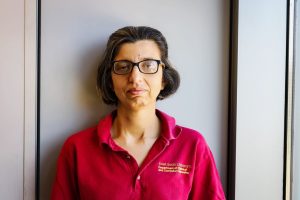
Whether you watch videos on a small phone screen or a large TV, minuscule structures and movements placed within each video allow it to run.
Namrata Vaswani, professor in the Department of Electrical and Computer Engineering (ECpE) at Iowa State University, along with Chinmay Hegde, ECpE assistant professor, recently received a nearly half million three-year grant from the National Science Foundation (NSF) for researching how the same type of structural dependencies can be exploited to develop novel algorithms for phase retrieval and other similar problems. Small grants such as this one are the most competitive and hardest to get since they are all faculty ranging from junior to mid-career and seniors tend to apply for them.
According to the project’s abstract, “This project develops the first set of provably correct, fast and low-sample-complexity algorithms for phaseless low rank matrix recovery in two settings – one of which has applications in fast and inexpensive phaseless imaging of slow changing dynamic scenes; while the second is will be useful for static imaging settings.” Moreover, “the project also develops provably fast and statistically efficient sparse PR algorithms and explores extensions to learning generalized linear models.”
Vaswani, the principal investigator (PI) of the project, explained that the algorithms developed by the team will result in low-cost solutions to numerous imaging applications such as high-resolution imaging of live biological specimens. Current solutions are either very slow or very expensive.
“If you have something really tiny to observe, you need either very powerful equipment or a lot of cheap sensors, e.g. cameras, combined in a careful fashion,” Vaswani said. “If in addition you also exploit structural correlations, you can get away with needing fewer cameras.”
But with the research that Vaswani, Hegde and their graduate students are doing, observing these structures will someday be at a more affordable price and a lower quantity of materials.
“The goal of the grant is to exploit the structure to be able to do microscopic work with inexpensive, low resolution microscopes,” Vaswani said.
Their objective is to reduce the cost of data acquisition in applications like imaging, where a specific nonlinear function is being observed. By exploiting the structure of the function, the team hopes to lower the expenses.
“If you looked at a regular video sequence, the foreground image sequence is sparse, not occupying the whole frame. There is a lot of this kind of structure in every natural data set that can be exploited,” Vaswani said.
“If our research is successful, then it would pave the way for new and improved imaging mechanisms at considerably reduced measurement costs, which may translate to immediate societal benefits,” Hegde said.
With the grant, Vaswani plans to help her students.
“All of my research only requires a computer, some grad students and our brains,” Vaswani said. “So $499,000 goes a long way.”